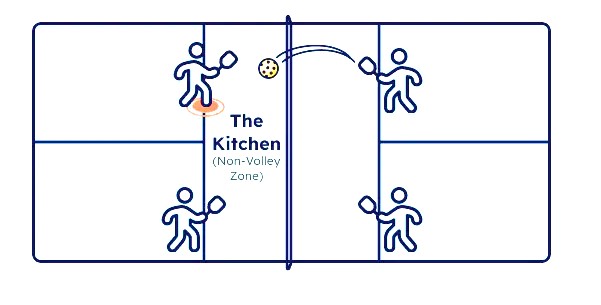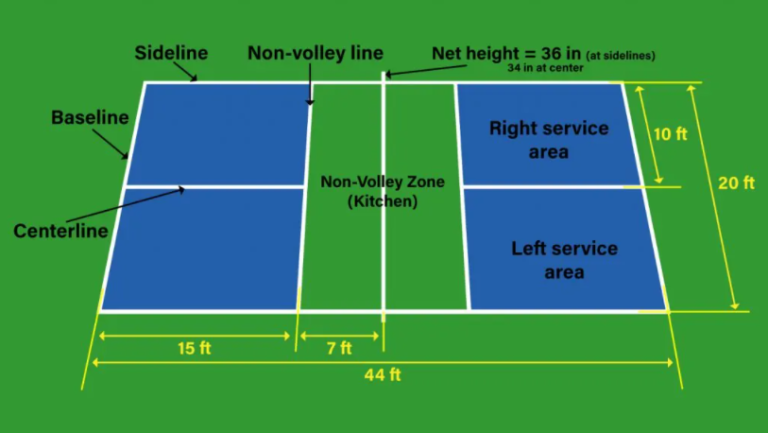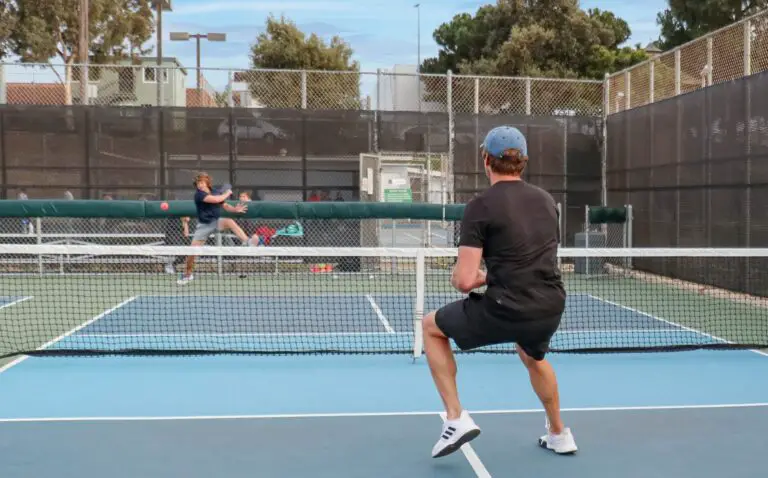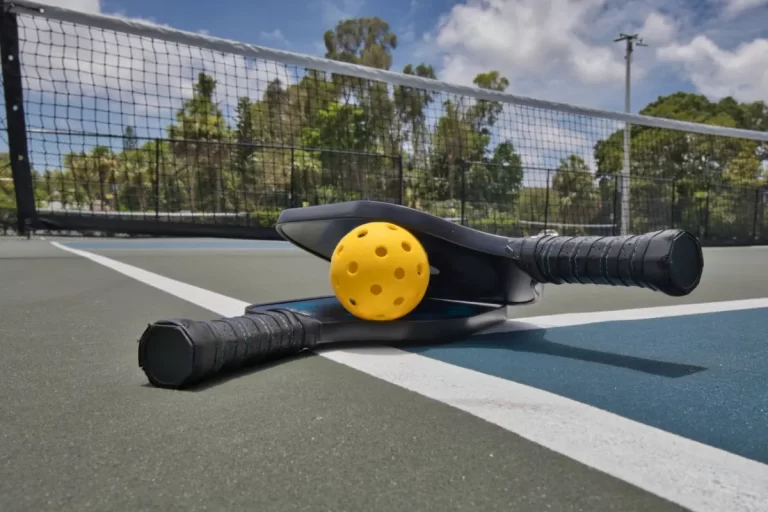How big is the kitchen in Pickleball
If you are new to the world of pickleball, you have probably heard the term “kitchen” being tossed around. But what exactly is the kitchen in pickleball, and how big is it? In this article, we will answer these questions and provide you with all the information you need to understand “How big is the kitchen in Pickleball?”
Like in any sport, there are game-specific regulations that specify how we can play to promote enjoyment, equity, and competition. One important and unique aspect of pickleball rules that sets it apart from other sports is the existence of a “kitchen” area near the net. This area is formally known as the non-volley zone.

Some people view it as a terrifying nightmare zone, while others see it as a strategically important area with lots of chances to win the game. All the information you need to know about the dimensions, rules, and use of the pickleball kitchen to improve your next pickleball match is listed below:
How big is the kitchen in Pickleball? Strategic Dimensions
The kitchen in Pickleball, also known as the non-volley zone (NVZ), is restricted by specific court lines. It extends seven feet back from the net and spans 20 feet in width, running parallel to the net. It’s worth noting that these measurements encompass the width of the line markings, which are typically around two inches wide.

The Kitchen zone in Pickleball is, by regulation, 44 feet in length and 20 feet in width. This specific measurement designates the Kitchen as the smallest area on the pickleball court, yet it carries significant strategic importance. It encompasses a seven-foot space from the net, spanning both sides of the court and extending from each sideline to the adjacent sideline.
This comprehensive coverage creates a rectangular region totaling 140 square feet, within which players must adhere to specific rules regarding volleys. While the Kitchen’s dimensions may make it seem compact, it plays a pivotal role in the sport, encouraging players to showcase their finesse, precision, and tactical prowess. It’s often said that the Kitchen is where some of the most critical moments and point-scoring opportunities in a pickleball match unfold.
Rules to Know About the Kitchen in Pickleball
The kitchen, also known as the non-volley zone (NVZ), is a fundamental component of pickleball, and understanding the rules associated with it is crucial for a successful game. Here are the fundamental rules to know about the kitchen:
- No Volleys Inside the Kitchen: The primary rule governing the kitchen is that players are not allowed to volley the ball (hit it in the air without it bouncing) while standing inside the kitchen.
- The 7-Foot Boundary: The kitchen extends seven feet from the net on both sides of the court, creating a 14-foot-wide no-volley zone at the net. This boundary is essential for player positioning and strategic gameplay.
- The Sideline and Baseline Boundaries: The kitchen is restricted by the baseline, the sideline, and a line perpendicular to the net, covering the space between these boundaries.
- Serving Beyond the Kitchen: When serving, it’s mandatory that the ball lands beyond the kitchen, including the NVZ line. If the ball bounces inside the kitchen during a serve, it results in a fault, and the opposing player or team gains a point.
- Foot Faults: Pay close attention to foot placement within the kitchen. Stepping on or over the kitchen boundary line while hitting the ball is considered a foot fault, leading to a point awarded to the opposing side.
- No Volley Zone Line: Players often position themselves along the no-volley zone line (kitchen line) to maximise control at the net. While they can stand here, they must still avoid volleying from this position.
- Volleys After a Bounce: To legally volley the ball, players must wait for it to bounce outside of the kitchen. Once the ball has bounced, they are free to move forward and engage in a volley.
- Pickleball Pertains to Serving: A crucial rule in pickleball pertains to serving. When serving, the ball must land beyond your opponent’s non-volley zone, which includes the NVZ line. If, during the serve, the ball bounces within the kitchen area, it results in a fault, and the opposing player or team is awarded the point. This rule ensures fair play and adds an element of strategy and precision to the game, emphasising the significance of ball placement during serves.
Tips for Playing in the Non-Volley Zone (Kitchen) in Pickleball
Mastering the art of playing within the non-volley zone (NVZ), commonly referred to as the kitchen, is essential for success in pickleball. Here are some valuable tips to help you excel when you’re in the kitchen:
Tip 1: Footwork and Positioning
Pay close attention to your footwork and positioning within the kitchen. Stay aware of your proximity to the NVZ line to avoid foot faults, and position yourself optimally to cover as many courts as possible.

Tip 2: Strategic Volleys
Remember that volleys are not allowed inside the kitchen. Focus on hitting strategic groundstrokes, dinks, and soft shots to keep the ball low and force your opponents into making mistakes.
Tip 3: Develop a Soft Touch
Work on developing a soft touch to excel in the kitchen. Practice dropping the ball gently over the net during dinking exchanges, and aim for precise placement to keep your opponent off balance.

Tip 4: Patience is Key
Be patient when playing in the kitchen. Wait for the right moment to attack and refrain from attempting volleys or overhead smashes while inside the NVZ.
Tip 5: Quick Reflexes
Maintain quick reflexes to respond to fast-paced exchanges. Your agility and ability to react swiftly to shots that approach the kitchen can make a significant difference in the outcome of rallies.
Tip 6: Communication with Your Partner
If you’re playing doubles, communication with your partner is crucial. Coordinate movements and strategies for covering the kitchen effectively and deciding when to switch positions.
Tip 7: Utilise Cross-Court Shots
Consider employing cross-court shots to exploit gaps in your opponents’ coverage. Hitting to the open areas can put pressure on your opponents and create opportunities for winners.
Tip 8: Stay Mindful of Opponents’ Positioning
Keep an eye on your opponents’ positioning, especially when they are in the kitchen. Exploit their weaknesses and anticipate their shots to gain the upper hand.
Tip 9: Develop a Consistent Dink
The dink is a foundational shot in pickleball played extensively within the kitchen. Work on maintaining consistency with your dinks, ensuring that you can place the ball precisely and consistently.
Tip 10: Practice, Practice, Practice
As with any skill, practice is essential. Regularly practicing within the kitchen will help you improve your control and decision-making in this crucial area of the court.
By implementing these tips and continually honing your skills in the non-volley zone, you’ll enhance your performance in pickleball and become a more formidable player, capable of winning points with precision, strategy, and finesse.
Conclusion about How big is the kitchen in Pickleball
In pickleball, the kitchen, or the non-volley zone, is a critical element that adds depth and strategy to the game. Understanding its dimensions and rules is essential for players at all skill levels. By respecting the rules of the kitchen, players can engage in fair and exciting matches that showcase their skills and teamwork.
FAQ for How big is the kitchen in Pickleball
What is the kitchen in pickleball?
The kitchen, also known as the non-volley zone (NVZ), is a designated area on the pickleball court, extending seven feet from the net on both sides and spanning from sideline to sideline.
Why is the kitchen essential in pickleball?
The kitchen is essential because it enforces rules that prevent players from hitting volleys near the net, promoting skill, finesse, and strategy over power. It balances the game and creates exciting dynamics.
Can I volley the ball inside the kitchen?
No, volleying the ball (hitting it in the air without it bouncing) is not allowed while standing inside the kitchen. Players must wait for the ball to bounce outside the kitchen before attempting a volley.
What happens if I serve in the kitchen?
If the ball bounces inside the kitchen during a serve, it is considered a fault, and the opposing player or team wins the point.
What is a foot fault in pickleball?
A foot fault occurs when a player steps over or on the NVZ line while hitting the ball, resulting in a point awarded to the opposing side.
Can I stand on the no-volley zone line (kitchen line)?
Yes, you can stand on the no-volley zone line (kitchen line) without violating the rules, but you still cannot volley the ball from this position.
What is the strategy for playing in the kitchen?
The strategy for the kitchen involves soft shots, dinking, and precise placement. Be patient, work on developing a soft touch, and aim for the open areas on the court to keep your opponents off balance.
How can I improve my game within the kitchen?
To improve your performance within the kitchen, practice your dinking, refine your positioning, develop quick reflexes, and work on your communication with your partner if you’re playing doubles.
What are the dimensions of the kitchen?
The kitchen in pickleball spans 44 feet in length and 20 feet in width, covering an area within 7 feet of the net on both sides and from sideline to sideline. It totals 140 square feet.
Is the kitchen the smallest area on the pickleball court?
Yes, the kitchen is the smallest area on the pickleball court, but it plays a vital role in the game’s dynamics, fostering skillful play and precise shot selection.








2 Comments
Comments are closed.